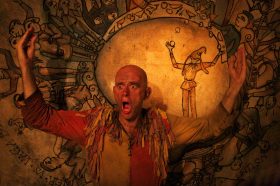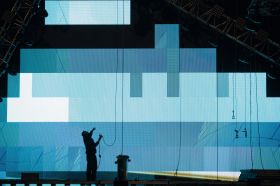Photo: Jeff Busby
Opening with the Norns failing to repair the iconic painted backcloth of Valhalla from Das Rheingold rather than their traditional spinning of the web of destiny, it collapses down around them as a portent of the gods’ actual and imminent downfall. Brünnhilde and Siegfried’s domicile has acquired a saggy looking mattress and Siegfried’s ‘Rhine Journey’ brought back the ‘Sea of Humaity’ and their aquatic impersonation except the new mixture of mime and loose, contemporary dance had less impact than their earlier impersonation of the water and gold.
Their contemporary look prepared for the visual shock as the Gibichung’s palace came into view. Gunther and Gutrune’s empire is a very contemporary one. He is a self styled commander with Hagen at his right hand side while his sister Gutrune is a comically ‘trashy’ bimbo.
All the scenes take place in a huge metal, house frame, open throughout act one and three or covered as a wedding marquee for act two where the vassals appear in black tie and the women dressed for an ostentatious society marriage. Of all of Robert Cousin’s sets this works best, allowing open, unadorned space or scene-specific objects as in the wedding scene.
Without their gold the showgirl Rheinmaidens have gone to seed. Their glamorous costumes are tatty and their gyrations to entice Siegfried to return the Ring more desperately sexual. None the less, their appearance prompted a break in the Wagnerian ritual of audience silence and they were given a round of applause as soon as they came in sight!
Siegfried’s death occurred in a rifle range where the men had gone with a supermarket trolley full of booze for some drinking and shooting. Even Siegfried is shot not speared and after his death a set of rituals take place for the opera’s conclusion. His body is washed but instead of being placed on a funeral bier the men paste his face with the same clown white make up donned by the delusional Fafner in the Siegfried.
Then stood upright, covered by a black veil the Sea of Humanity surround him with bouquets of flowers suggesting familiar ritual response to events like the death of Princess Diana.
He is joined by Brünnhilde in her famous immolation scene which ends with the entire house frame blazing with real flame and her standing beside him in a grotesque parody of a wedding cake ornament.
Director Neil Armfield’s challenging but cohesive interpretations made meaning in the previous operas. Concluding Götterdämmerung with these modern responses to tragedy has less immediate meaning than those in the preceding operas. Alice Babidge’s costumes for the wedding, particularly Gutrune’s tasteless wedding ensemble have the same quiet wit that occasionally prompts laugh out loud elements like the ever-popular Rhinemaidens or Siegfried’s K-Mart boys’ wear.
Vocally Susan Bullock’s Brünnhilde was wild and murderous in her public outbursts, thrilling in the second act where she delivered a blistering oath of vengeance but deeply human sounding for the final scene.
Stefan Vinke continued to sing with astounding vigour. His ringing top notes will not be easily forgotten nor will the beautiful, soft tones in his death.
Damiel Sumegi was a Stalinesque looking Hagen. His best singing was in his quietly malicious ‘Watch’ scene and the ghostly father-son scene with Alberich sung as well as ever by Warwick Fyfe. Waltraute was thrillingly sung by Deborah Humble. Her scene with Brünnhilde was one of the highlights of the performance.
Rhinemaidens, Lorina Gore, Jane Eade and Domenica Matthews sang beautifully and were beautifully supported by the Melbourne Ring Orchestra, in the ebb and flow of the music. Conductor Pietari Inkinen created a spacious blanket of sound. Heard from the upper reaches of the theatre the voices and orchestra wove around each other: the expanded orchestra and pit are certainly capable greater volume than normally heard in this theatre but the sound was warm and immediate. The Funeral March was overwhelming but not overbearing.
With nearly the entire company on stage, including the orchestra, the performance was given a 10-minute ovation. So, while not everything in Armfield’s vision may have come across, a lot of Wagner’s musical vision did.
5 stars
Further information and ticket availability available at: melbourneringcycle.com.au





